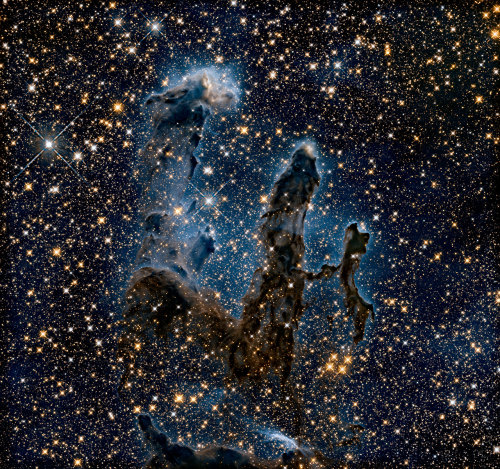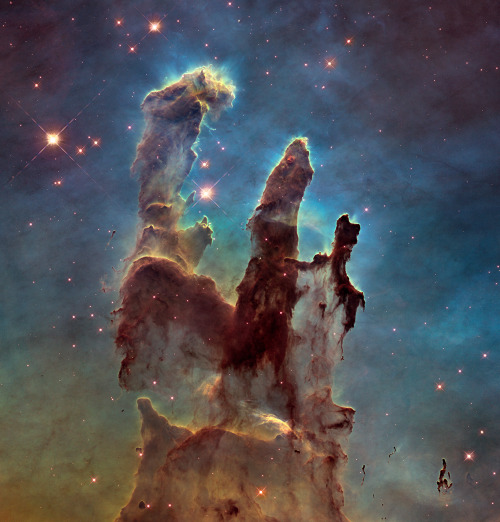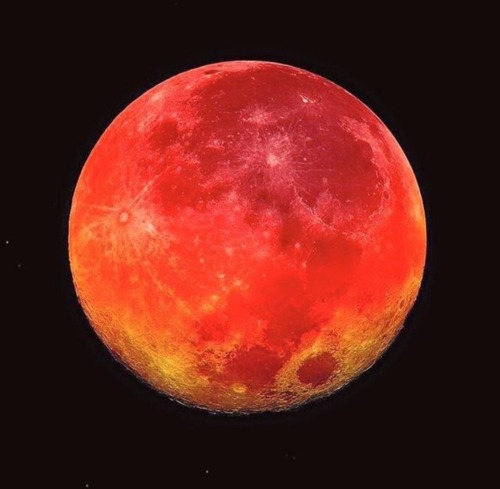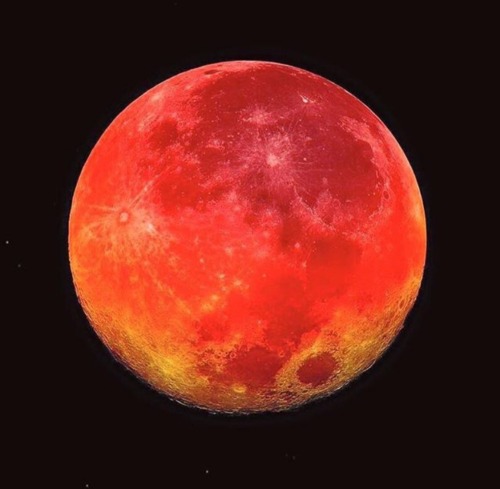Sometimes… There’s More Than Meets The Eye. 👀 You’re Looking At Two Very Different Takes On


Sometimes… there’s more than meets the eye. 👀 You’re looking at two very different takes on an iconic image.
Human eyes can see only a small portion of the range of radiation given off by the objects around us. We call this wide array of radiation the electromagnetic spectrum, and the part we can see visible light.
In the first image, researchers revisited one of Hubble Space Telescope’s most popular sights: the Eagle Nebula’s Pillars of Creation. Here, the pillars are seen in infrared light, which pierces through obscuring dust and gas and unveil a more unfamiliar — but just as amazing — view of the pillars. The entire frame is peppered with bright stars and baby stars are revealed being formed within the pillars themselves. The image on the bottom is the pillars in visible light.
Image Credit: NASA, ESA/Hubble and the Hubble Heritage Team
Make sure to follow us on Tumblr for your regular dose of space: http://nasa.tumblr.com.
More Posts from Starry-shores and Others



“You’re basically seeing all of the sunrises and sunsets across the world, at once, being reflected off the surface of the moon” – NASA
Asimov invented the three laws of robotics and spent most of his robot books pulling them apart and exploring why they wouldn’t work but why they couldn’t really be improved, either.
Most robot revolution stories assume the danger is when robots stop obeying us and start thinking for themselves.
Asimov’s stories suggest that the real danger is robots doing exactly what we tell them to.
I think that’s both more realistic and actually scarier.
Helicoprion: What if, like, teeth,
Mesosaurus: Yeah?
Helicoprion: but WHEEL
Mesosaurus: No don't -
Helicoprion:

(Image by ДиБгд)
So I just discovered that the famous depth chart of Lake Baikal, you know, this one

Is
Uh
Not the whole picture

So this is going to haunt me forever
I love the fact that a group of crows is called a "Murder" and a group of ravens is a "Conspiracy"
The Kepler space telescope has shown us our galaxy is teeming with planets — and other surprises

The Kepler space telescope has taught us there are so many planets out there, they outnumber even the stars. Here is a sample of these wondrous, weird and unexpected worlds (and other spectacular objects in space) that Kepler has spotted with its “eye” opened to the heavens.
Kepler has found that double sunsets really do exist.

Yes, Star Wars fans, the double sunset on Tatooine could really exist. Kepler discovered the first known planet around a double-star system, though Kepler-16b is probably a gas giant without a solid surface.
Kepler has gotten us closer to finding planets like Earth.

Nope. Kepler hasn’t found Earth 2.0, and that wasn’t the job it set out to do. But in its survey of hundreds of thousands of stars, Kepler found planets near in size to Earth orbiting at a distance where liquid water could pool on the surface. One of them, Kepler-62f, is about 40 percent bigger than Earth and is likely rocky. Is there life on any of them? We still have a lot more to learn.
This sizzling world is so hot iron would melt!

One of Kepler’s early discoveries was the small, scorched world of Kepler-10b. With a year that lasts less than an Earth day and density high enough to imply it’s probably made of iron and rock, this “lava world” gave us the first solid evidence of a rocky planet outside our solar system.
If it’s not an alien megastructure, what is this oddly fluctuating star?

When Kepler detected the oddly fluctuating light from “Tabby’s Star,” the internet lit up with speculation of an alien megastructure. Astronomers have concluded it’s probably an orbiting dust cloud.
Kepler caught this dead star cannibalizing its planet.

What happens when a solar system dies? Kepler discovered a white dwarf, the compact corpse of a star in the process of vaporizing a planet.
These Kepler planets are more than twice the age of our Sun!

The five small planets in Kepler-444 were born 11 billion years ago when our galaxy was in its youth. Imagine what these ancient planets look like after all that time?
Kepler found a supernova exploding at breakneck speed.

This premier planet hunter has also been watching stars explode. Kepler recorded a sped-up version of a supernova called a “fast-evolving luminescent transit” that reached its peak brightness at breakneck speed. It was caused by a star spewing out a dense shell of gas that lit up when hit with the shockwave from the blast.
* All images are artist illustrations.
Make sure to follow us on Tumblr for your regular dose of space: http://nasa.tumblr.com
-
 whateverthewiz reblogged this · 1 month ago
whateverthewiz reblogged this · 1 month ago -
 whateverthewiz liked this · 1 month ago
whateverthewiz liked this · 1 month ago -
 jfictitional liked this · 1 month ago
jfictitional liked this · 1 month ago -
 nvrknowsbest liked this · 1 month ago
nvrknowsbest liked this · 1 month ago -
 carpe-kairos liked this · 1 month ago
carpe-kairos liked this · 1 month ago -
 gomodernart liked this · 1 month ago
gomodernart liked this · 1 month ago -
 powlor liked this · 1 month ago
powlor liked this · 1 month ago -
 abstractandedgyname liked this · 1 month ago
abstractandedgyname liked this · 1 month ago -
 o-blivia reblogged this · 1 month ago
o-blivia reblogged this · 1 month ago -
 cybermax reblogged this · 1 month ago
cybermax reblogged this · 1 month ago -
 isbbc liked this · 2 months ago
isbbc liked this · 2 months ago -
 cybermax liked this · 2 months ago
cybermax liked this · 2 months ago -
 kachowwshrek liked this · 2 months ago
kachowwshrek liked this · 2 months ago -
 icyhot65 liked this · 2 months ago
icyhot65 liked this · 2 months ago -
 wafflefriesandbowties reblogged this · 2 months ago
wafflefriesandbowties reblogged this · 2 months ago -
 wafflefriesandbowties liked this · 2 months ago
wafflefriesandbowties liked this · 2 months ago -
 adventurespnw reblogged this · 2 months ago
adventurespnw reblogged this · 2 months ago -
 adventurespnw liked this · 2 months ago
adventurespnw liked this · 2 months ago -
 mysinfulthoughts reblogged this · 2 months ago
mysinfulthoughts reblogged this · 2 months ago -
 whatareyoureallyafraidof reblogged this · 2 months ago
whatareyoureallyafraidof reblogged this · 2 months ago -
 tooshytoexist reblogged this · 3 months ago
tooshytoexist reblogged this · 3 months ago -
 thewriteitinerary reblogged this · 8 months ago
thewriteitinerary reblogged this · 8 months ago -
 jadedpeakearthghoul liked this · 1 year ago
jadedpeakearthghoul liked this · 1 year ago -
 neist reblogged this · 1 year ago
neist reblogged this · 1 year ago -
 brightmane57 reblogged this · 1 year ago
brightmane57 reblogged this · 1 year ago -
 brightmane57 liked this · 1 year ago
brightmane57 liked this · 1 year ago -
 foxysoxes liked this · 1 year ago
foxysoxes liked this · 1 year ago -
 impossiblewizardtraveler-blog reblogged this · 1 year ago
impossiblewizardtraveler-blog reblogged this · 1 year ago -
 impossiblewizardtraveler-blog liked this · 1 year ago
impossiblewizardtraveler-blog liked this · 1 year ago -
 bowlingbum liked this · 1 year ago
bowlingbum liked this · 1 year ago -
 swords0827 liked this · 1 year ago
swords0827 liked this · 1 year ago -
 stefan13exe liked this · 1 year ago
stefan13exe liked this · 1 year ago -
 clonejack liked this · 1 year ago
clonejack liked this · 1 year ago -
 1412kk reblogged this · 1 year ago
1412kk reblogged this · 1 year ago -
 1412kk liked this · 1 year ago
1412kk liked this · 1 year ago -
 whatareyoureallyafraidof reblogged this · 1 year ago
whatareyoureallyafraidof reblogged this · 1 year ago -
 kanicolle liked this · 1 year ago
kanicolle liked this · 1 year ago -
 saphicspacesociety14 reblogged this · 1 year ago
saphicspacesociety14 reblogged this · 1 year ago -
 thenecropolix reblogged this · 1 year ago
thenecropolix reblogged this · 1 year ago -
 svarte-troner liked this · 1 year ago
svarte-troner liked this · 1 year ago -
 crucrionnia reblogged this · 1 year ago
crucrionnia reblogged this · 1 year ago -
 urdagtafuly liked this · 1 year ago
urdagtafuly liked this · 1 year ago

Amateur astronomer, owns a telescope. This is a side blog to satiate my science-y cravings! I haven't yet mustered the courage to put up my personal astro-stuff here. Main blog : @an-abyss-called-life
212 posts


